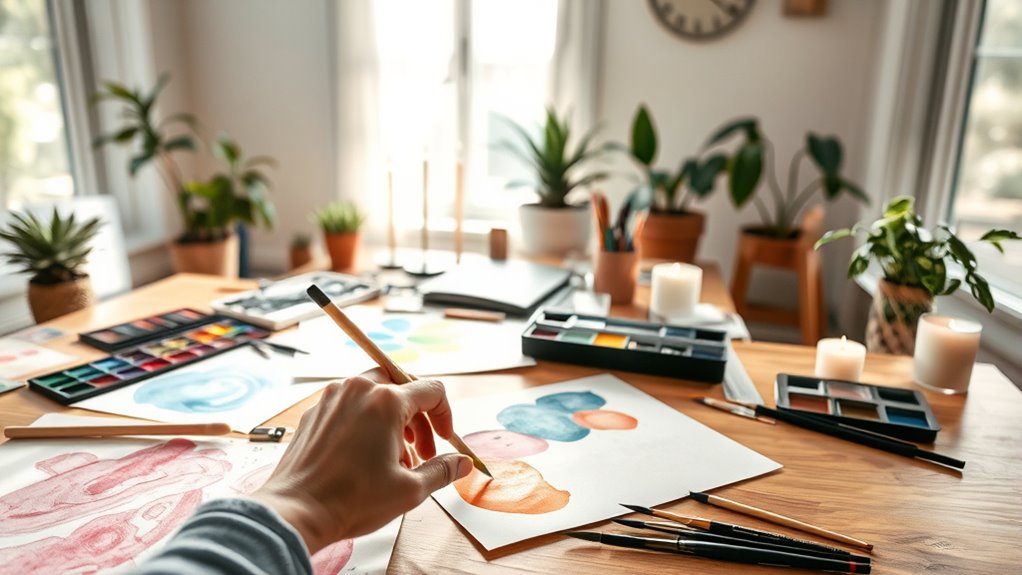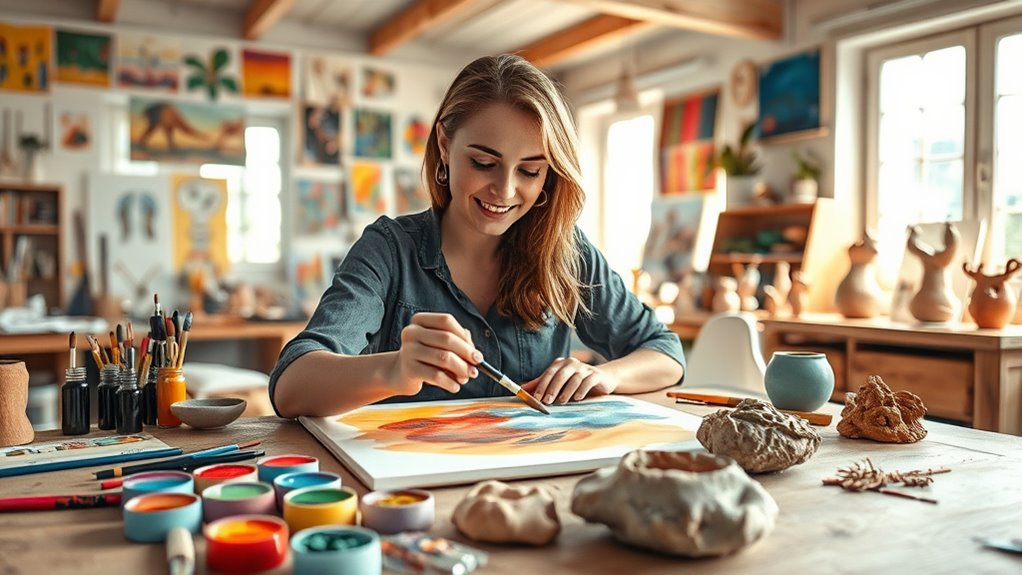Art therapy helps you manage stress by allowing you to express emotions that are hard to put into words. It encourages mindfulness and keeps you focused on the present, which reduces feelings of overwhelm. Creating art can be calming, empowering, and offer insights into your emotional state, helping you develop healthier coping strategies. Incorporating artistic activities into your routine can boost resilience and inner peace, so keep exploring ways to access these calming benefits.
Key Takeaways
- Art therapy facilitates emotional expression and tension release, promoting relaxation and stress reduction.
- Engaging in creative processes helps shift focus away from worries, fostering mindfulness and calmness.
- Visual art allows for self-exploration, revealing emotional patterns and enhancing self-understanding.
- Artistic activities provide a safe, non-judgmental space to process difficult feelings and build resilience.
- Incorporating art into routine self-care encourages ongoing emotional healing and inner peace.

When stress starts to take over your life, turning to art therapy can offer a powerful way to find relief. You might discover that engaging in creative expression helps you process complex emotions and releases built-up tension. Unlike traditional talk therapy, art therapy allows you to communicate feelings that are often hard to put into words. As you create, you’re not just producing beautiful images; you’re also giving your mind a chance to explore and understand what’s happening inside. This process supports emotional healing, helping you gain clarity and calm amid chaos.
Engaging in art therapy helps process emotions and find calm amid chaos.
As you pick up brushes, pencils, or any art supplies, you connect with your inner self in a unique way. You’re not concerned about the quality of your work—your focus is on expressing what’s inside. This act of creating becomes a safe space where emotions can surface freely, whether it’s anger, sadness, or anxiety. Over time, this creative expression becomes a therapeutic tool, enabling you to confront and work through feelings that might otherwise stay bottled up. The physical act of making art stimulates your brain’s emotional centers, encouraging release and relief. It’s a process that’s both soothing and empowering, giving you a sense of control over your emotional state.
Engaging in art therapy also encourages mindfulness, helping you stay present in the moment. As you immerse yourself in colors, textures, and shapes, your mind shifts away from stressors and worries, reducing feelings of overwhelm. This mindful focus fosters emotional resilience by reinforcing your ability to stay centered during difficult times. Plus, creating art doesn’t require special skills—just a willingness to explore and express yourself. Whether you’re doodling, painting, or collaging, the act of making art becomes a ritual that supports emotional health.
You’ll find that as you incorporate creative expression into your routine, you gain insight into your emotional landscape. The visual representations you produce can reveal patterns and triggers, helping you understand what influences your stress levels. This understanding is key to emotional healing, as it empowers you to develop healthier coping strategies. Additionally, the use of high-quality honey products in your daily routine can enhance your overall well-being and support stress reduction through natural benefits. Over time, the process of making art becomes more than just a distraction; it transforms into a meaningful way to nurture your mental well-being. When you give yourself permission to create freely, you’re actively participating in your own healing journey, fostering resilience, and cultivating inner peace through artistic expression.
Frequently Asked Questions
Can Art Therapy Replace Traditional Stress Management Methods?
You might wonder if art therapy can replace traditional stress management techniques. While it offers unique benefits like emotional expression and creativity, it’s often best used alongside methods like exercise or mindfulness. Comparing these techniques shows that art therapy can enhance emotional release and reduce stress, but it may not fully replace proven strategies. Incorporate art therapy as a complementary tool to create a well-rounded approach to managing your stress effectively.
Is Prior Artistic Skill Necessary to Benefit From Art Therapy?
You don’t need artistic ability or a high skill level to benefit from art therapy. The focus isn’t on creating perfect art but on expressing yourself and exploring emotions. Whether you’re a beginner or experienced, engaging in creative activities helps reduce stress and improve well-being. So, don’t worry about your skill level—just get creative and allow yourself to experience the calming benefits art therapy offers.
How Often Should I Practice Art Therapy for Stress Relief?
Think of your stress relief journey as tending a garden—you’ll need regular care. You should practice art therapy at least 3-4 times a week, fitting into your daily routine. Keep sessions around 30 to 60 minutes to maximize benefits. Consistency is key; the more you nurture your creative outlet, the more your stress will diminish, helping you grow calmer and more centered with each session.
Are There Specific Art Mediums Recommended for Stress Reduction?
You might find certain art mediums more helpful for stress reduction. Experiment with painting techniques like watercolor or acrylic to express emotions freely. Collage methods can also be soothing, allowing you to assemble images and textures that reflect your feelings. The key is choosing mediums that feel enjoyable and relaxing to you. Focus on the process, not perfection, and let your creativity serve as a calming outlet.
Can Children and Seniors Benefit Equally From Art Therapy?
You might think children and seniors are worlds apart, but both can benefit immensely from art therapy. It’s like opening a treasure chest of healing for child development and senior well-being. While their needs differ, art helps them express emotions, improve cognition, and find joy. So yes, both age groups can gain equally, experiencing growth and relaxation through creative outlets that nurture their unique journeys.
Conclusion
You might find that expressing yourself through art truly helps ease your stress. Some believe that creating art activates your brain’s relaxation response, releasing feel-good chemicals like endorphins. While scientific evidence is still growing, many people swear by how art therapy calms their mind and body. So, next time life feels overwhelming, grab some supplies and get creative—you might just discover a powerful, healing escape that’s always within your reach.









